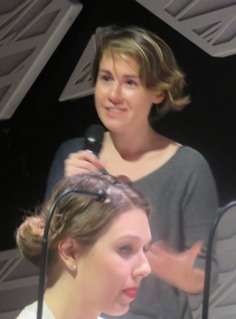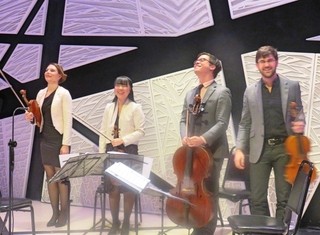|
Back
Ms. Shaw’s Magical Quintet New York
National Sawdust
12/11/2016 -
Caroline Shaw: Entr’acte – Blueprint – Plan and Elevation – Punctum – Valencia
Attacca Quartet: Amy Schroeder, Keiko Tokunaga (Violins), Nathan Schram (Viola), Andrew Yee (Cello)

C. Shaw (with mike), A. Schroeder, at National Sawdust
(© Samuel A. Dog)
“...many hundred years from now, in winter, in the splendor of the snow and woods...”
Walt Whitman: Poets To Come (1860)
An agonizing choice. Do I halt at dusk on the banks of Walt Whitman’s Brooklyn East River, the season’s first snows of winter falling through on the water? Or do I stroll southeast two blocks to National Sawdust for a concert of string quartet music by the lithe, lively Caroline Shaw, played by the Attacca Quartet?
Duty (a most pleasant duty) overcame frosty pleasure. The hour’s quintet of Ms. Shaw’s music couldn’t quite compare with Nature’s bounty. But Ms. Shaw’s most human inspirations–each of them new to me–satisfied another part of the soul.
I had heard Caroline Shaw’s music several times over the past years, and it was always revelatory. She was the youngest ever Pulitzer Prize winner (then in her middle-twenties), but initially I had no idea of age or honors. As a singer with a most haunting voice, as violinist with the Acme Quartet, and as composer with The Walking Man, she proved a rare fascinating musician.
The music was played by the splendid Attacca Quartet, which, as young as Ms. Shaw herself. And it showed a woman who–first of all–obviously knows her strings. While nothing was easy here, it was obvious that she had composed for instruments which were hardly second fiddle (so to speak) for her. The plethora of techniques–pizzicati rebounding against the wood, bowing on the bridge, exaggerated bow pressure–seemed natural, virtually inevitable.
The complexities were manifold, yet the challenges fit the Attacca well. Mainly strings playing a 64th or so behind or in front of others, leading to a glory of sounds that came out of nowhere. Even in the simplest moments, like the opening of Entr’acte, all four strings played a consonant tune with dissonances of a minor second, giving a rare feeling that something was wrong..or perhaps it was right in its own eccentric way.
Yet these were moments. What one felt essentially is an American music. Music which, no matter how complex, had an American feel, a jauntiness, even the 17th Century sound of church singing , or an advanced Henry Cowell Hymn and Fuguing Tune.
Then there were the changes of mood. Changes which came suddenly. A passage might be soothing or exciting us, and suddenly it would change to an almost unheard series of notes from cello or viola with no harmonies at all.
Excuse the comparison, but Ms. Shaw’s changes of mood echoed what Elliott Carter used to say about Mozart’s chamber music: that he didn’t give a damn for “classical order” but composed whatever he felt like, changing and altering according to his instinct rather than the rules of the house.
Part of my own intuition, though, was purely imaginative. For while Ms. Shaw’s moods changed with alacrity, I felt an affection for Punctum, where she retained a steady, serious forward mood. Where I could relax consciousness into what I felt was a comfortable music.
“Aha,” thought I, “Caroline Shaw has assembled and disassmbled a William Billings hymn tune, and put it back together again after a glorious climax.” Except that it wasn’t put together. It finished, like so many of Ms. Shaw’s pieces, with sounds that floated away into the atmosphere. As if the very idea of a tonic-dominant cadence would have been an end. And perhaps she wanted us to long for more.
Er...except that my identity of Billings wasn’t an error. Ms. Shaw explained that it wasn’t the 18th Century American hymn-maker at all. It was a guy named J.S. Bach. (Blush). At any rate, they were both chorales, both Baroque, and Ms. Shaw is American enough to have perhaps unconsciously morphed Bach into psaltery music.

A. Schroeder, K. Tokunaga, N. Schram, A. Yee (© Samuel A. Dog)
Fortuitously, I didn’t catch the title of the final work Valencia until later, lest I would have searched for Iberian rhythms. Instead, the Attacca Quartet, which seemed to enjoy every measure of the music, played with a series of sounds (those so-frequent pizzicatos!), changing colors, altering measures, keeping a light and jaunty humor.
Again later, I discovered that the Valencia of the title referred to essence of the Valencia orange.
Perhaps an homage to The Magic Fruit?
That first work, Entra’cte was indeed a sort of 18th Century minuet complete with trio–and with her trademark unanticipated near-silences, the almost invisible notes plucked to the end.
Blueprint was a stirring work which started with stentorian measures which Beethoven would have written. Except that we had another transition leading to a beautiful slow cadenza by Amy Schroeder.
But it was Plan and Elevation which gave me unalloyed pleasure. Yes, obviously the first downward notes were Three Blind Mice, repeated with the usual configurations. After that, though, Ms. Shaw launched into the most gorgeous developments. Developments for each instrument played against a background of the most diverse colors. Instruments playing across all four strings or with canonic pizzicatos or with the softest counterpoint.
And when the first nursery-rhyme three-note theme was played backwards, it wasn’t to show a particular skill or clever artifice. The music sounded inevitable. Just as her textures and lines offered a series of glowing moments. Like Carter’s last chamber music, Ms. Shaw’s quartets were composed not with rules or strictures, but for the joy of writing itself.

East River Winter (© Samuel A. Dog)
And when it was over, I felt so delighted that it was necessary to have the complement of Nature’s joy. So wandered down to the river, and let myself be fulfilled by more notes. The white-and-black notes of snow in the darkness on the silent river.
Harry Rolnick
|